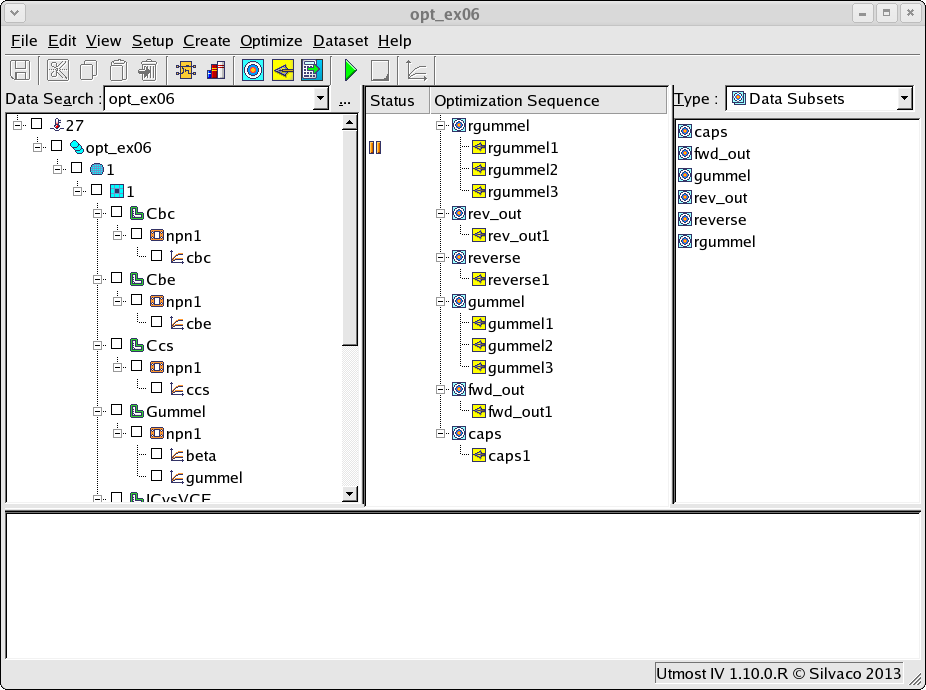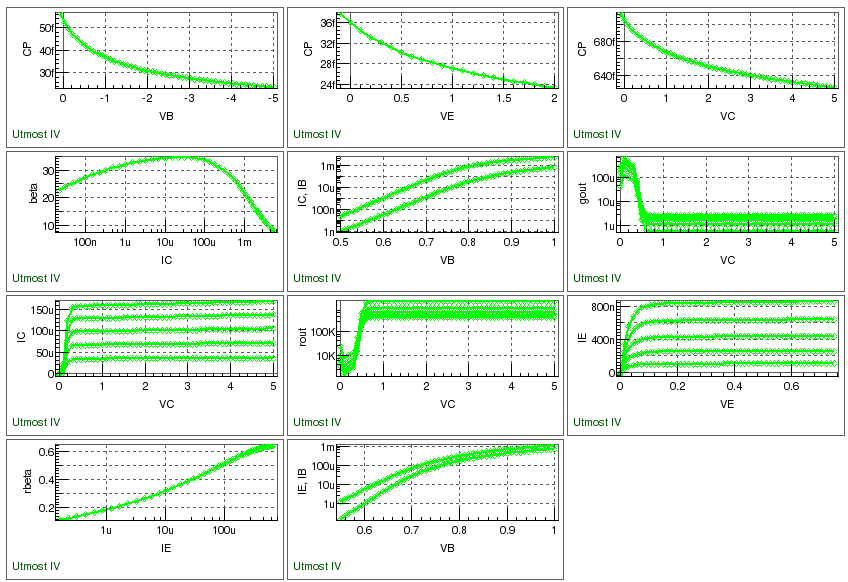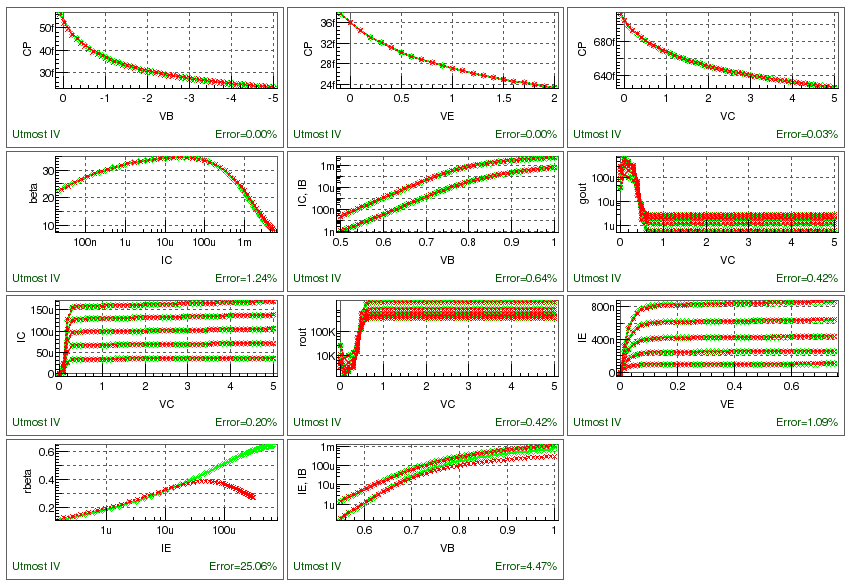opt_ex06 : Gummel-Poon Bipolar Model Extraction
Requires: Utmost IV, SmartSpice, SmartView
Minimum Versions: Utmost IV 1.10.6.R, SmartSpice 4.10.2.R, SmartView 2.28.2.R
This example describes how to extract a standard Gummel-Poon model for a bipolar transistor. To extract the model, typical forward and reverse operation DC characteristics and reverse bias capacitance characteristics of each junction are required.
The project file opt_ex06.prj and the data file opt_ex06.uds for this example should be loaded into your database. When opened, the project will look as shown in opt_ex06_01.png and when plotted, the example measured data will look as shown in opt_ex06_02.png .
The optimization sequence, which fully automates the extraction of this Gummel-Poon bipolar model example, has six sections. The objective of each section is to isolate a device characteristic and then to optimize only those model parameters which account for this device behaviour. However, it is especially true of the bipolar Gummel-Poon model that certain values of the reverse characteristic parameters will affect the modeling of the forward operation and vice versa. It may be necessary to repeat the sequence several times to achieve the best model fit to your data.
The first section optimizes the parameters IS , NR , BR , ISC , NC , IKR , RBM and RC to model the reverse Gummel data. Following this the parameters VAR and IKR are optimized to fit to the reverse output characteristics. In the third section, both of the reverse datasets are included and all of the parameters again optimized to achieve the best fit to all of the reverse data together.
Since the most important operation of the bipolar transistor is the forward operation, this will be optimized after the reverse parameters. In this way, goodness of fit to the reverse characteristics can be sacrificed in order to achieve a good model in forward operation.
The fourth section optimizes the parameters IS , NF , BF , ISE , NE , RE , IKF , and RBM to achieve the best fit to the forward Gummel data. Then in the fifth section the parameters VAF and IKF are optimized to fit to the forward output characteristics.
In the final section, all three of the bipolar junction capacitances are optimized at the same time, to extract the CJE , MJE , VJE , CJC , MJC , VJC , CJS , MJS and VJS model parameters.
On completion of the sequence, the measured versus simulated characteristics should be as shown in opt_ex06_03.png . If necessary the entire sequence can be run multiple times in order to achieve a good fit to the measured data. The model card can then be exported into an external model library file as shown in the output file opt_ex06.lib.
opt_ex06.lib
.LIB demo .MODEL npn NPN ( +LEVEL = 1 IS = 1e-16 BF = 37.9747 +NF = 1 BR = 5.17617 NR = 1 +ISE = 3.37284e-15 NE = 1.65304 ISC = 2.21865e-13 +NC = 1.35444 VAF = 63.3792 VAR = 10.4944 +IKF = 0.00182126 IKR = 0.0001 RB = 1854.54 +RBM = 60.4543 IRB = 1.21914e-06 RE = 10 +RC = 69.0206 CJE = 3.59001e-14 VJE = 0.686403 +MJE = 0.313618 FC = 0.5 CJC = 5.25001e-14 +VJC = 0.551295 MJC = 0.346841 CJS = 7.05712e-13 +VJS = 0.501668 MJS = 0.05 TF = 1e-10 +XTF = 1 ITF = 0.01 VTF = 5 +PTF = 20 TR = 1e-08 XTB = 1.5 +EG = 1.17 XTI = 3 ) .ENDL demo
opt_ex06.uds
Utmost IV CSV Data Logfile Format Version 1 Copyright (c) 1984 - 2016 Silvaco, Inc. All rights reserved DataSetStart DataSetName, Cbc MeasurementType, LCR BatchName, opt_ex06 WaferName, 1 DieName, 1 GroupName, 1, 0, 12000 DeviceName, npn1 Temperature, 27 FabDate, 23 Apr 2007 UserDate, 23 Apr 2007 WaferDiameter, 200 DieSize, 20, 20 NodeNames, C B E S LCRSource, B, C, 1e+06, V, 0 LCRTarget, CP Sweep, 1, V_LCR, LIN, 0.1, -5, -0.1, CALCULATED Constant, V, E, 0, 0.1, 0.0 Constant, V, C, 0, 0.1, 0.0 Constant, V, S, 0, 0.1, 0.0 Function, VB, VC + V_LCR Plot, cbc, XY (LIN LIN), VB, CP DataArray, CP 5.6274e-14 5.25e-14 4.95507e-14 4.71557e-14 4.51556e-14 4.34492e-14 4.19687e-14 4.06667e-14 3.95087e-14 3.8469e-14 3.75281e-14 3.66708e-14 3.58848e-14 3.51604e-14 3.44897e-14 3.38661e-14 3.32841e-14 3.27391e-14 3.22272e-14 3.17451e-14 3.12898e-14 3.08588e-14 3.04501e-14 3.00615e-14 2.96916e-14 2.93387e-14 2.90016e-14 2.8679e-14 2.83699e-14 2.80734e-14 2.77886e-14 2.75146e-14 2.72509e-14 2.69967e-14 2.67515e-14 2.65147e-14 2.62859e-14 2.60645e-14 2.58502e-14 2.56426e-14 2.54413e-14 2.5246e-14 2.50564e-14 2.48722e-14 2.46932e-14 2.4519e-14 2.43496e-14 2.41846e-14 2.40239e-14 2.38672e-14 2.37144e-14 2.35654e-14 DataSetFinish DataSetStart DataSetName, Cbe MeasurementType, LCR BatchName, opt_ex06 WaferName, 1 DieName, 1 GroupName, 1, 0, 12000 DeviceName, npn1 Temperature, 27 FabDate, 23 Apr 2007 UserDate, 23 Apr 2007 WaferDiameter, 200 DieSize, 20, 20 NodeNames, C B E S LCRSource, E, B, 1e+06, V, 0 LCRTarget, CP Sweep, 1, V_LCR, LIN, -0.1, 2, 0.1, CALCULATED Constant, V, C, 0, 0.1, 0.0 Constant, V, B, 0, 0.01, 0.0 Constant, V, S, 0, 0.1, 0.0 Function, VE, VB + V_LCR Plot, cbe, XY (LIN LIN), VE, CP DataArray, CP 3.77173e-14 3.59e-14 3.4401e-14 3.31335e-14 3.20411e-14 3.10853e-14 3.02387e-14 2.94809e-14 2.87968e-14 2.81746e-14 2.76051e-14 2.70809e-14 2.65961e-14 2.61456e-14 2.57255e-14 2.53323e-14 2.4963e-14 2.46154e-14 2.42871e-14 2.39764e-14 2.36818e-14 2.34017e-14 DataSetFinish DataSetStart DataSetName, Ccs MeasurementType, LCR BatchName, opt_ex06 WaferName, 1 DieName, 1 GroupName, 1, 0, 12000 DeviceName, npn1 Temperature, 27 FabDate, 23 Apr 2007 UserDate, 23 Apr 2007 WaferDiameter, 200 DieSize, 20, 20 NodeNames, C B E S LCRSource, C, S, 1e+06, V, 0 LCRTarget, CP Sweep, 1, V_LCR, LIN, -0.1, 5, 0.1, CALCULATED Constant, V, E, 0, 0.1, 0.0 Constant, V, B, 0, 0.01, 0.0 Constant, V, S, 0, 0.1, 0.0 Function, VC, VS + V_LCR Plot, ccs, XY (LIN LIN), VC, CP DataArray, CP 7.12799e-13 7.05e-13 6.98691e-13 6.93402e-13 6.88852e-13 6.84863e-13 6.81315e-13 6.78121e-13 6.75218e-13 6.72559e-13 6.70106e-13 6.67831e-13 6.65709e-13 6.63723e-13 6.61855e-13 6.60093e-13 6.58426e-13 6.56844e-13 6.55339e-13 6.53905e-13 6.52534e-13 6.51222e-13 6.49964e-13 6.48756e-13 6.47594e-13 6.46474e-13 6.45395e-13 6.44352e-13 6.43344e-13 6.42369e-13 6.41424e-13 6.40508e-13 6.39619e-13 6.38756e-13 6.37917e-13 6.371e-13 6.36306e-13 6.35531e-13 6.34777e-13 6.34041e-13 6.33323e-13 6.32621e-13 6.31936e-13 6.31267e-13 6.30612e-13 6.29971e-13 6.29344e-13 6.2873e-13 6.28128e-13 6.27539e-13 6.2696e-13 6.26394e-13 DataSetFinish DataSetStart DataSetName, Gummel MeasurementType, DC BatchName, opt_ex06 WaferName, 1 DieName, 1 GroupName, 1, 0, 12000 DeviceName, npn1 Temperature, 27 FabDate, 23 Apr 2007 UserDate, 23 Apr 2007 WaferDiameter, 200 DieSize, 20, 20 NodeNames, C B E S Sweep, 1, V, B, LIN, 0.5, 1, CALCULATED, 51, 0.1 Constant, V, E, 0, 0.1, 0.0 Constant, V, S, 0, 0.1, 0.0 Constant, V, C, 2, 0.1, 0.0 Target, I, B Target, I, C Function, beta, IC / IB Plot, beta, XY (LOG LIN), IC, beta Plot, gummel, XY (LIN LOG), VB, IC IB DataArray, IB 9.39533e-10 1.31163e-09 1.83968e-09 2.59186e-09 3.66703e-09 5.2088e-09 7.42606e-09 1.06231e-08 1.52436e-08 2.19352e-08 3.16434e-08 4.57493e-08 6.62701e-08 9.61498e-08 1.3968e-07 2.03102e-07 2.95463e-07 4.2981e-07 6.24814e-07 9.06919e-07 1.31304e-06 1.89372e-06 2.71653e-06 3.86918e-06 5.46176e-06 7.62758e-06 1.05222e-05 1.43209e-05 1.92144e-05 2.54033e-05 3.30923e-05 4.24832e-05 5.37685e-05 6.71257e-05 8.27128e-05 0.000100665 0.000121093 0.000144082 0.000169695 0.00019797 0.000228926 0.000262564 0.000298869 0.000337815 0.000379362 0.000423465 0.000470071 0.000519121 0.000570555 0.000624308 0.000680316 DataArray, IC 2.14005e-08 3.14807e-08 4.63087e-08 6.81202e-08 1.00203e-07 1.47394e-07 2.16802e-07 3.18878e-07 4.68981e-07 6.89668e-07 1.01405e-06 1.49066e-06 2.19057e-06 3.21755e-06 4.72269e-06 6.92482e-06 1.01388e-05 1.48128e-05 2.1576e-05 3.12933e-05 4.51206e-05 6.45428e-05 9.13719e-05 0.000127674 0.000175612 0.000237223 0.000314184 0.000407631 0.000518093 0.000645515 0.000789361 0.000948728 0.00112247 0.00130929 0.00150782 0.0017167 0.00193459 0.00216021 0.00239238 0.00263 0.00287208 0.00311773 0.00336616 0.00361667 0.00386865 0.00412157 0.00437497 0.00462844 0.00488165 0.00513431 0.00538616 DataSetFinish DataSetStart DataSetName, ICvsVCE MeasurementType, DC BatchName, opt_ex06 WaferName, 1 DieName, 1 GroupName, 1, 0, 12000 DeviceName, npn1 Temperature, 27 FabDate, 23 Apr 2007 UserDate, 23 Apr 2007 WaferDiameter, 200 DieSize, 20, 20 NodeNames, C B E S Sweep, 1, V, C, LIN, 0, 5, CALCULATED, 51, 0.1 Sweep, 2, I, B, LIN, 1e-06, CALCULATED, 1e-06, 5, 2 Constant, V, S, 0, 0.1, 0.0 Constant, V, E, 0, 0.1, 0.0 Target, I, C Function, rout, 1 / gout Function, gout, derivative (VC, IC) Plot, gout, XY (LIN LOG), VC, gout Plot, icvce, XY (LIN LIN), VC, IC Plot, rout, XY (LIN LOG), VC, rout DataArray, IC -9.96026e-07 2.85571e-06 2.57363e-05 3.30161e-05 3.35889e-05 3.36736e-05 3.37291e-05 3.37828e-05 3.38364e-05 3.389e-05 3.39437e-05 3.39973e-05 3.40509e-05 3.41045e-05 3.41582e-05 3.42118e-05 3.42654e-05 3.4319e-05 3.43726e-05 3.44263e-05 3.44799e-05 3.45335e-05 3.45871e-05 3.46408e-05 3.46944e-05 3.4748e-05 3.48016e-05 3.48553e-05 3.49089e-05 3.49625e-05 3.50161e-05 3.50697e-05 3.51234e-05 3.5177e-05 3.52306e-05 3.52842e-05 3.53379e-05 3.53915e-05 3.54451e-05 3.54987e-05 3.55523e-05 3.5606e-05 3.56596e-05 3.57132e-05 3.57668e-05 3.58205e-05 3.58741e-05 3.59277e-05 3.59813e-05 3.6035e-05 3.60886e-05 -1.98977e-06 7.23369e-06 5.21727e-05 6.52664e-05 6.62991e-05 6.64604e-05 6.65696e-05 6.66758e-05 6.67818e-05 6.68877e-05 6.69937e-05 6.70996e-05 6.72056e-05 6.73116e-05 6.74175e-05 6.75235e-05 6.76295e-05 6.77354e-05 6.78414e-05 6.79474e-05 6.80533e-05 6.81593e-05 6.82652e-05 6.83712e-05 6.84772e-05 6.85831e-05 6.86891e-05 6.87951e-05 6.8901e-05 6.9007e-05 6.9113e-05 6.92189e-05 6.93249e-05 6.94308e-05 6.95368e-05 6.96428e-05 6.97487e-05 6.98547e-05 6.99607e-05 7.00666e-05 7.01726e-05 7.02786e-05 7.03845e-05 7.04905e-05 7.05964e-05 7.07024e-05 7.08084e-05 7.09143e-05 7.10203e-05 7.11263e-05 7.12322e-05 -2.98148e-06 1.21652e-05 7.76875e-05 9.63592e-05 9.78457e-05 9.80816e-05 9.82428e-05 9.83995e-05 9.85561e-05 9.87125e-05 9.8869e-05 9.90255e-05 9.9182e-05 9.93385e-05 9.9495e-05 9.96515e-05 9.9808e-05 9.99645e-05 0.000100121 0.000100277 0.000100434 0.00010059 0.000100747 0.000100903 0.00010106 0.000101216 0.000101373 0.000101529 0.000101686 0.000101842 0.000101999 0.000102155 0.000102312 0.000102468 0.000102625 0.000102781 0.000102938 0.000103094 0.000103251 0.000103407 0.000103564 0.00010372 0.000103877 0.000104033 0.00010419 0.000104346 0.000104503 0.000104659 0.000104816 0.000104972 0.000105129 -3.97113e-06 1.73663e-05 0.00010214 0.000126358 0.000128309 0.000128619 0.00012883 0.000129036 0.000129241 0.000129446 0.000129652 0.000129857 0.000130062 0.000130268 0.000130473 0.000130678 0.000130884 0.000131089 0.000131294 0.0001315 0.000131705 0.00013191 0.000132116 0.000132321 0.000132526 0.000132732 0.000132937 0.000133142 0.000133347 0.000133553 0.000133758 0.000133963 0.000134169 0.000134374 0.000134579 0.000134785 0.00013499 0.000135195 0.000135401 0.000135606 0.000135811 0.000136017 0.000136222 0.000136427 0.000136633 0.000136838 0.000137043 0.000137249 0.000137454 0.000137659 0.000137865 -4.95867e-06 2.26936e-05 0.000125533 0.000155346 0.00015778 0.000158163 0.000158423 0.000158676 0.000158929 0.000159181 0.000159434 0.000159687 0.000159939 0.000160192 0.000160444 0.000160697 0.00016095 0.000161202 0.000161455 0.000161707 0.00016196 0.000162212 0.000162465 0.000162718 0.00016297 0.000163223 0.000163475 0.000163728 0.000163981 0.000164233 0.000164486 0.000164738 0.000164991 0.000165243 0.000165496 0.000165749 0.000166001 0.000166254 0.000166506 0.000166759 0.000167012 0.000167264 0.000167517 0.000167769 0.000168022 0.000168274 0.000168527 0.00016878 0.000169032 0.000169285 0.000169537 DataSetFinish DataSetStart DataSetName, IEvsVCE MeasurementType, DC BatchName, opt_ex06 WaferName, 1 DieName, 1 GroupName, 1, 0, 12000 DeviceName, npn1 Temperature, 27 FabDate, 23 Apr 2007 UserDate, 23 Apr 2007 WaferDiameter, 200 DieSize, 20, 20 NodeNames, C B E S Sweep, 1, V, E, LIN, 0, 0.75, CALCULATED, 51, 0.1 Sweep, 2, I, B, LIN, 1e-06, CALCULATED, 1e-06, 5, 2 Constant, V, S, 0, 0.1, 0.0 Constant, V, C, 0, 0.1, 0.0 Target, I, E Plot, ievec, XY (LIN LIN), VE, IE DataArray, IE -3.97448e-09 3.99618e-08 6.47407e-08 7.87161e-08 8.66105e-08 9.10848e-08 9.36362e-08 9.51063e-08 9.59682e-08 9.64875e-08 9.68139e-08 9.70314e-08 9.71874e-08 9.73086e-08 9.741e-08 9.75001e-08 9.75838e-08 9.76639e-08 9.77418e-08 9.78185e-08 9.78945e-08 9.79701e-08 9.80454e-08 9.81206e-08 9.81957e-08 9.82707e-08 9.83457e-08 9.84207e-08 9.84957e-08 9.85706e-08 9.86456e-08 9.87205e-08 9.87955e-08 9.88704e-08 9.89454e-08 9.90203e-08 9.90953e-08 9.91702e-08 9.92451e-08 9.93201e-08 9.9395e-08 9.947e-08 9.95449e-08 9.96198e-08 9.96948e-08 9.97697e-08 9.98447e-08 9.99196e-08 9.99946e-08 1.00069e-07 1.00144e-07 -1.02257e-08 1.00895e-07 1.63602e-07 1.98969e-07 2.18939e-07 2.3025e-07 2.36694e-07 2.40402e-07 2.42573e-07 2.43879e-07 2.44699e-07 2.45245e-07 2.45637e-07 2.45941e-07 2.46196e-07 2.46423e-07 2.46634e-07 2.46836e-07 2.47033e-07 2.47227e-07 2.47419e-07 2.4761e-07 2.47801e-07 2.47991e-07 2.48181e-07 2.48371e-07 2.48561e-07 2.4875e-07 2.4894e-07 2.4913e-07 2.4932e-07 2.49509e-07 2.49699e-07 2.49889e-07 2.50079e-07 2.50268e-07 2.50458e-07 2.50648e-07 2.50837e-07 2.51027e-07 2.51217e-07 2.51407e-07 2.51596e-07 2.51786e-07 2.51976e-07 2.52165e-07 2.52355e-07 2.52545e-07 2.52735e-07 2.52924e-07 2.53114e-07 -1.85209e-08 1.72496e-07 2.80375e-07 3.41238e-07 3.75603e-07 3.95062e-07 4.06143e-07 4.12516e-07 4.16245e-07 4.18487e-07 4.19893e-07 4.20829e-07 4.21499e-07 4.2202e-07 4.22457e-07 4.22846e-07 4.23208e-07 4.23555e-07 4.23893e-07 4.24225e-07 4.24555e-07 4.24883e-07 4.25211e-07 4.25537e-07 4.25864e-07 4.2619e-07 4.26516e-07 4.26842e-07 4.27168e-07 4.27494e-07 4.2782e-07 4.28145e-07 4.28471e-07 4.28797e-07 4.29123e-07 4.29449e-07 4.29775e-07 4.301e-07 4.30426e-07 4.30752e-07 4.31078e-07 4.31404e-07 4.3173e-07 4.32056e-07 4.32381e-07 4.32707e-07 4.33033e-07 4.33359e-07 4.33685e-07 4.34011e-07 4.34336e-07 -2.88726e-08 2.51567e-07 4.10083e-07 4.9955e-07 5.50071e-07 5.78675e-07 5.9496e-07 6.04324e-07 6.09799e-07 6.13089e-07 6.15151e-07 6.16523e-07 6.17505e-07 6.18268e-07 6.18908e-07 6.19478e-07 6.20008e-07 6.20516e-07 6.21011e-07 6.21498e-07 6.21982e-07 6.22463e-07 6.22943e-07 6.23422e-07 6.239e-07 6.24378e-07 6.24856e-07 6.25334e-07 6.25812e-07 6.26289e-07 6.26767e-07 6.27245e-07 6.27723e-07 6.282e-07 6.28678e-07 6.29156e-07 6.29633e-07 6.30111e-07 6.30589e-07 6.31066e-07 6.31544e-07 6.32022e-07 6.32499e-07 6.32977e-07 6.33455e-07 6.33932e-07 6.3441e-07 6.34888e-07 6.35365e-07 6.35843e-07 6.36321e-07 -4.13292e-08 3.36352e-07 5.50027e-07 6.70678e-07 7.3882e-07 7.77401e-07 7.99362e-07 8.11987e-07 8.19365e-07 8.23798e-07 8.26574e-07 8.28419e-07 8.2974e-07 8.30766e-07 8.31626e-07 8.32391e-07 8.33104e-07 8.33786e-07 8.34452e-07 8.35107e-07 8.35757e-07 8.36404e-07 8.37049e-07 8.37692e-07 8.38335e-07 8.38978e-07 8.39621e-07 8.40263e-07 8.40905e-07 8.41548e-07 8.4219e-07 8.42832e-07 8.43474e-07 8.44117e-07 8.44759e-07 8.45401e-07 8.46043e-07 8.46685e-07 8.47328e-07 8.4797e-07 8.48612e-07 8.49254e-07 8.49896e-07 8.50538e-07 8.51181e-07 8.51823e-07 8.52465e-07 8.53107e-07 8.53749e-07 8.54392e-07 8.55034e-07 DataSetFinish DataSetStart DataSetName, RGummel MeasurementType, DC BatchName, opt_ex06 WaferName, 1 DieName, 1 GroupName, 1, 0, 12000 DeviceName, npn1 Temperature, 27 FabDate, 23 Apr 2007 UserDate, 23 Apr 2007 WaferDiameter, 200 DieSize, 20, 20 NodeNames, C B E S Sweep, 1, V, B, LIN, 0.55, 1, CALCULATED, 51, 0.1 Constant, V, E, 2, 0.1, 0.0 Constant, V, S, 0, 0.1, 0.0 Constant, V, C, 0, 0.1, 0.0 Target, I, B Target, I, E Function, rbeta, IE / IB Plot, rbeta, XY (LOG LIN), IE, rbeta Plot, rgummel, XY (LIN LOG), VB, IE IB DataArray, IB 1.32684e-06 1.71508e-06 2.21616e-06 2.86211e-06 3.69351e-06 4.76135e-06 6.1291e-06 7.87485e-06 1.00931e-05 1.28963e-05 1.64144e-05 2.07937e-05 2.61927e-05 3.27747e-05 4.06992e-05 5.01107e-05 6.11279e-05 7.38355e-05 8.82786e-05 0.000104463 0.000122358 0.000141905 0.000163022 0.000185615 0.000209582 0.000234821 0.000261233 0.000288723 0.000317203 0.000346593 0.000376821 0.00040782 0.000439533 0.000471906 0.000504894 0.000538453 0.000572547 0.000607143 0.00064221 0.000677721 0.000713653 0.000749984 0.000786693 0.000823763 0.000861178 0.000898923 0.000936983 0.000975348 0.001014 0.00105294 0.00109215 DataArray, IE 1.55404e-07 2.19037e-07 3.08369e-07 4.33501e-07 6.08295e-07 8.51629e-07 1.18894e-06 1.65411e-06 2.2915e-06 3.15819e-06 4.32583e-06 5.88187e-06 7.92936e-06 1.05849e-05 1.39742e-05 1.8225e-05 2.34591e-05 2.97834e-05 3.72823e-05 4.60131e-05 5.6004e-05 6.72554e-05 7.97433e-05 9.34245e-05 0.000108242 0.000124128 0.00014101 0.000158816 0.00017747 0.000196902 0.000217044 0.000237832 0.000259205 0.000281109 0.000303492 0.000326309 0.000349515 0.000373072 0.000396944 0.000421098 0.000445505 0.000470137 0.000494969 0.00051998 0.000545148 0.000570454 0.000595882 0.000621415 0.000647038 0.00067274 0.000698506 DataSetFinish




